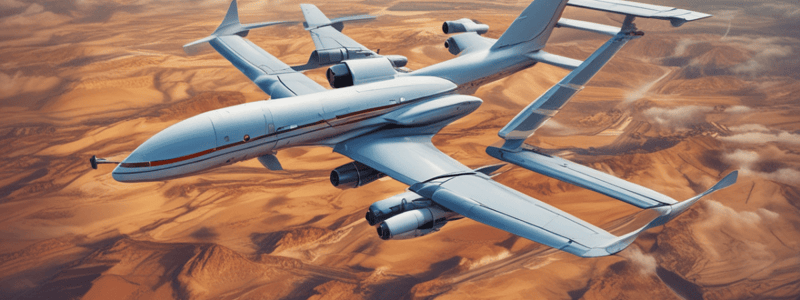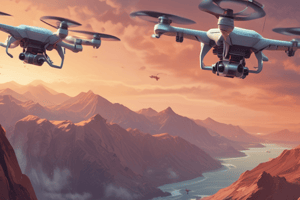Podcast
Questions and Answers
What is the purpose of the pinpoint feature in camera control?
What is the purpose of the pinpoint feature in camera control?
- To allow easy sharing of location information (correct)
- To improve drone battery performance
- To stabilize video footage
- To enhance image quality during recording
Which flight mode is not available for the drone?
Which flight mode is not available for the drone?
- Normal mode
- Attitude mode
- Sport mode
- Altitude mode (correct)
What should the drone's battery voltage not drop below for safe flight?
What should the drone's battery voltage not drop below for safe flight?
- 3.6 volts per cell (correct)
- 14.0 volts for a 4-cell battery
- 3.0 volts per cell
- 17.2 volts for a 4-cell battery
Which camera setting allows for automatic adjustment of exposure?
Which camera setting allows for automatic adjustment of exposure?
What is the function of dewarping in gimbal settings?
What is the function of dewarping in gimbal settings?
Which storage setting is important for managing space on the SD card?
Which storage setting is important for managing space on the SD card?
How are media files organized after a mission?
How are media files organized after a mission?
Which autofocus setting allows focusing on a single point?
Which autofocus setting allows focusing on a single point?
What feature is useful for ensuring stable video footage while shooting?
What feature is useful for ensuring stable video footage while shooting?
The gimbal control buttons include pitch up, recenter, and yaw.
The gimbal control buttons include pitch up, recenter, and yaw.
The telemetry display shows the drone's battery temperature.
The telemetry display shows the drone's battery temperature.
The 3.6 volt rule applies to a 3-cell battery.
The 3.6 volt rule applies to a 3-cell battery.
The autofocus continuous setting allows focusing on a single point.
The autofocus continuous setting allows focusing on a single point.
The frame arm LEDs remain on during shooting.
The frame arm LEDs remain on during shooting.
Study Notes
Camera Control and Settings
- Wide camera view can be accessed by clicking the wide button on the green box
- Zoom camera view can be accessed by clicking the zoom button on the green box
- Gimbal control buttons: pitch down, recenter, and pinpoint feature to record a location of a particular object
- Pinpoint feature allows easy sharing of location information with incident command
Flight Mode and Telemetry
- Flight modes: normal, attitude, and sport mode
- Telemetry display: RC connection to the drone, drone's battery voltage (aggregate), and number of satellites
- 3.6 volt rule: drone's battery voltage should not drop below 3.6 volts per cell, or 14.4 volts for a 4-cell battery, to ensure safe flight home
Camera Settings
- Exposure settings: ISO, shutter, EV, AE (automatic exposure)
- Focus settings: autofocus continuous, spot, AFC (autofocus continuous), AF (autofocus), and manual focus
- Camera control: manual, shutter priority, and aperture control
- Storage display: available space on the SD card
Camera and Gimbal Settings
- Camera settings: image ratio (4x3), image format (JPEG, RAW, or JPEG+RAW)
- Gimbal settings: lock gimbal while shooting (useful for mapping), mechanical shutter, and dewarping
- Dewarping: crops in and dewarps images, useful for mapping
- Frame arm LEDs: automatically turn off during shooting
Organizing Media
- Create a new folder for each mission type (e.g., mapping, orbits, progression) to organize media
- Media is automatically sorted into folders based on the mission type
Camera Control and Settings
- Access wide camera view by clicking the wide button on the green box
- Access zoom camera view by clicking the zoom button on the green box
- Gimbal control features pitch down, recenter, and pinpoint functions
- Pinpoint feature shares location information with incident command
Flight Mode and Telemetry
- Three flight modes: normal, attitude, and sport mode
- Telemetry display shows RC connection, drone's battery voltage, and number of satellites
- 3.6 volt rule: maintain a minimum of 3.6V per cell (14.4V for a 4-cell battery) for safe flight home
Camera Settings
- Exposure settings: ISO, shutter, EV, and AE (automatic exposure)
- Focus settings: autofocus continuous, spot, AFC, AF, and manual focus
- Camera control modes: manual, shutter priority, and aperture control
- Storage display shows available space on the SD card
Camera and Gimbal Settings
- Image settings: 4:3 ratio, JPEG, RAW, or JPEG+RAW format
- Gimbal settings: lock during shooting (useful for mapping), mechanical shutter, and dewarping
- Dewarping: crops and dewarps images for mapping purposes
- Frame arm LEDs automatically turn off during shooting
Organizing Media
- Create separate folders for each mission type (e.g., mapping, orbits, progression)
- Media is automatically sorted into folders based on mission type
Camera Control and Settings
- Access wide camera view by clicking the wide button on the green box
- Access zoom camera view by clicking the zoom button on the green box
- Gimbal control features pitch down, recenter, and pinpoint functions
- Pinpoint feature shares location information with incident command
Flight Mode and Telemetry
- Three flight modes: normal, attitude, and sport mode
- Telemetry display shows RC connection, drone's battery voltage, and number of satellites
- 3.6 volt rule: maintain a minimum of 3.6V per cell (14.4V for a 4-cell battery) for safe flight home
Camera Settings
- Exposure settings: ISO, shutter, EV, and AE (automatic exposure)
- Focus settings: autofocus continuous, spot, AFC, AF, and manual focus
- Camera control modes: manual, shutter priority, and aperture control
- Storage display shows available space on the SD card
Camera and Gimbal Settings
- Image settings: 4:3 ratio, JPEG, RAW, or JPEG+RAW format
- Gimbal settings: lock during shooting (useful for mapping), mechanical shutter, and dewarping
- Dewarping: crops and dewarps images for mapping purposes
- Frame arm LEDs automatically turn off during shooting
Organizing Media
- Create separate folders for each mission type (e.g., mapping, orbits, progression)
- Media is automatically sorted into folders based on mission type
Studying That Suits You
Use AI to generate personalized quizzes and flashcards to suit your learning preferences.
Description
Learn about the various camera views, gimbal controls, and flight modes of a drone. Understand how to use the pinpoint feature and telemetry display.




